Researchers have, for the first time, detected a rare species of ‘Roundleaf Bat’ known by its scientific name, “Hipposideros lankadiva”, in Kased caves in Rajasthan’s Karauli district. The bat species is generally found in the Indian sub-continent and in neighbouring Sri Lanka, Bangladesh and Myanmar.
The rare insectivorous bat was spotted in a group of 150 in eastern Rajasthan, who have monitored their new population since 2010. An international Journal of Threatened Taxa disclosed its discovery in its January 26, 2023 issue.
Advertisement
The Indian Roundleaf Bat is endemic to southern Asia, and has been recorded from many parts of India, as well as neighbouring nations like Sri Lanka, Bangladesh, and Myanmar, Dr Dau Lal Bohra, a noted bat scientist who led the research work along with Dr Dharmendra Khandal of Tiger Watch Organisation told SNS here on Friday.
This very insectivorous bat survives mainly on butterfly (Hymenoptera species) and moth (Lepidoptera species) commonly seen in agriculture and chambal river fronts, he said.
The population of H lankadiva occurs in a natural cave between the Kailadevi Wildlife Sanctuary and National Chambal Gharial Sanctuary in Karauli, Rajasthan, India. The precise location is a Hindu religious site known as the Kased Cave near the town of Karanpur.
The cave is situated on a low hill close to the contiguous Vindhya hill range of Kailadevi WS. Due to its holy status, no tree felling has occurred in its immediate vicinity although the local community has completely denuded its surrounding areas, according to the research paper.
Five individuals of the species were captured in hand nets at Kased Cave, Karanpur, and Karauli. The captured bats have been released after taking morphometric measurements. All data was compared with available literature to conclude a final result.
The pelage of the bats varied from yellowish-brown to dark brown. They were darker on the head & shoulders and paler on the underside. Morphologically, there is no extraneous character variation from different species ranges in males and females between the five samples.
H lankadiva (1850) is a Large Leaf-nosed Bat having four (additional) supplementary leaflets on the nose-leaf with the 4th leaflet reduced, which is a key character of the species present in all specimens. The length of the ear was also an important parameter in this species.
“Its life is about 10 to12 years and dies automatically when its reproductive fail after they eat pesticide or insecticide infected insects from the agriculture field or river fronts,” he replied when asked.
Dr Bohra’s research paper claimed that no such species of Roundleaf bat (H.lankadiva) was earlier spotted in Bhim Bharak caves of Jodhpur in Rajasthan as misquoted in a few studies.
Zoological Survey of India (ZSI) shall come forward to protect and conserve this very bat species which is endemic too, he opined in his study.











